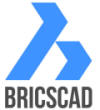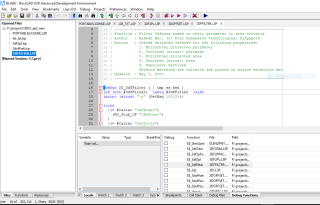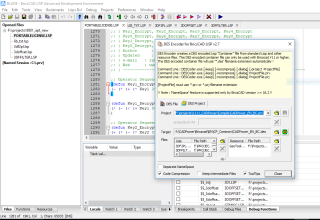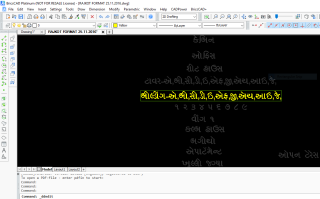BricsCAD Gets a Brand New Lisp IDE in V 18.2 Update, Delivers a Clutch of New UX Features
Bengaluru, India

V 18.2
Every year, during the life-cycle of the major numbered version, Bricsys release a two or three major updates that introduce new features and delivers on the promise Bricsys would have made during the preceding annual conference in October.
And today is the day we celebrate the release of BricsCAD V 18.2, the first major release in this life-cycle that packs in a long laundry list of new items added and existing ones improved.
If there is one way to describe this new release, it is one that fired on all cylinders!!
BricsCAD V 18.2 Update
Lisp goes Visual: The BLADE command opens up a new API environment: As a Lisp developer myself, I must give this prime space.
The brain-child of Torsten Moses, BricsCAD finally has an ultra-modern IDE for writing, debugging and compiling Lisp & DCL code.
Lisp is the most common and widely used customization platform for AutoCAD and BricsCAD but, in AutoCAD, it never received the importance it deserved. Lisp has grown from strength to strength in BricsCAD.
In V 18.2, there is brand new built-from-ground-up integrated development environment called the BLADE (BricsCAD Lisp Advanced Development Environment) that offers stiff competition to VLIDE from AutoCAD.

The BLADE editor is sharper than all other IDEs for Lisp
More about the BLADE IDE in another blog post, but this is a complete debugger and development platform for writing Lisp code.
Other than AutoCAD, BricsCAD now becomes the first other .dwg platform that offers a complete dedicated editor for Lisp developers.
Indeed, this is a great achievement and boosts the morale of a large number of Lisp programmers who had to depend on the humble text editor to write their code.
BricsCAD BLADE editor combines the ability to error-check LSP and DCL code, step through them during execution and watch the variables through breakpoints and also compile them into an encrypted format called the .DES format (equivalent of AutCAD’s FAS or VLX formats).
The DESCODER utility which was available as a stand-alone tool is now integrated inside the BLADE editor.

DESCODER utility now runs off the Projects menu from within BLADE
A new family of CENTER commands launched:
A bunch of new commands for creating and editing the center-line and center-mark entity types are available in V18.2:
- CENTERLINE creates a center line.
- CENTERMARK… yeah, you guessed it.
- CENTERREASSOCIATE re-associates a center line or a center mark.
- CENTERDISASSOCIATE does the exact opposite of the command above.
- CENTERRESET resets the entity’s properties.
New entity types mean new settings, too:
- CENTEREXE: specifies the length of centerline extensions.
- CENTERMARKEXE: Do centerlines extend automatically from new center marks? Yay or nay.
- CENTERLTYPEFILE: specifies the line type file used to create center marks and center lines.
- CENTERLTYPE: specifies the line type used by center marks and center lines.
- CENTERLAYER: sets the default layer for new center marks or center lines.
- CENTERLTSCALE: specifies the line type scale used by center marks and center lines.
- CENTERCROSSSIZE: sets the size of a center mark.
- CENTERCROSSGAP: size of the gap, in drawing units, between the center mark and its center lines.
This is a basic drafting feature added, and it is applies to the Classic version too.
TEXT EDIT ‘IN-PLACE’

Gujarati Text (VAKIL font) from a drawing is now being edited “In-Place”
In-place editing of text is supported in BricsCAD V18.2. The TEXTED setting controls the behavior of the text editor:
- 0 = use the in-place editor
- 1 = use the pop-up dialog box editor
- 2 = use the in-place editor with repeated input
No one knows the importance of this command more than the one who uses non-English fonts and the one that does only text editing for a majority part of the day (drawing conversion and editing companies).
This was one of the key requirements from one of our users and I am happy to see that it is now implemented.
Improvements in handling large PDF files:
PDF UNDERLAY CACHE
I quote from the Release Notes:
“Serious geek-ism here: in V18.2, we’ve implemented a multi-resolution, persistent image cache to display attached Pdf underlays.
This cool bit of kit enables (very) fast Zoom and Pan operations. The highest cached resolution is 5000 x 5000 pixels, so when zooming in very close, the display of the Pdf underlay will become pixelated. But this unsightly situation doesn’t need to trouble you – hit the cache limit and we can shift to a hybrid mode that regenerates the underlay image in real-time.
The generation of the image cache may take a few seconds, once, from then on the performance gain is persistent. For weeks, months… you name it. The pdf cache is used for display only, so it does not influence snapping or printing.”
In simple words, if you are one of those who will bring up a 30MB image packed into a PDF and want to painstaking hunt for the feature you want to digitize, this cache improvement comes to your rescue.
PDFCACHE
We all need to take care of exceptions and have a fall-back mechanism. A new BricsCAD setting that controls how Pdf caching is now available to revert or not depending on the need of the hour:
- 0 = don’t use Pdf cache, always use real-time generation of the Pdf underlay image. (This mode was the default in BricsCAD prior to V18.2)
- 1 = use Pdf cache and switch over to real-time generation when zooming past the cache resolution.
- 2 = always use Pdf cache (new default setting).
Improvements in BIM commands
BIM commands are new because their user-base is small yet fast growing.
A dedicated bunch of users are on an over-drive to take them to the next level. They are in a constant state of improvements.
We see AI techniques in the code and user-taught & machine-learnt behavior making its appearance in V 18.2 of BricsCAD.
The BIMIFY, BIMLINEARSOLID, BIMRECALCULATEAXIS, BIMADDECCENTRICITY, BIMATTACHCOMPOSITION, BIMDRAG, BIMCONNECT, BIMPROFILES and BMUNLINK are a few commands that have become smarter in V 18.2
Improvements in API
There cannot be a BricsCAD update without huge improvements in API. In fact, Bricsys developers lay as much importance in improving the API as much as the UX.
Once again, we see Lisp API getting a shot in its arm with a number of new features in the Sheet Metal API.
I will cover more of the Lisp API for Sheet Metal and BIM in another post but I must make a mention of it here for the record.
